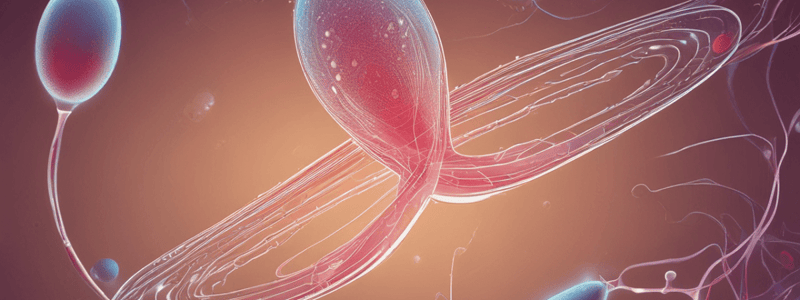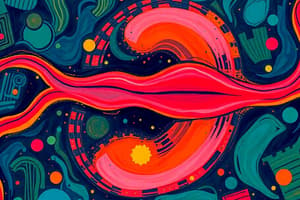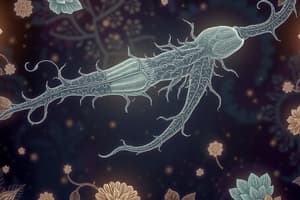Podcast
Questions and Answers
What is the primary function of the Leydig cells?
What is the primary function of the Leydig cells?
- Phagocytose excess spermatids
- Nourish spermatocytes
- Form the blood-testes barrier
- Secrete the male hormone testosterone (correct)
Which structure supports the testes?
Which structure supports the testes?
- Seminal vesicles
- Prostate gland
- Penis
- Scrotum (correct)
What is the average temperature required for normal sperm production and survival relative to core body temperature?
What is the average temperature required for normal sperm production and survival relative to core body temperature?
- 5°C below core body temperature
- 2-3°C below core body temperature (correct)
- 5°C above core body temperature
- 2-3°C above core body temperature
Which hormone helps regulate sperm production by inhibiting FSH?
Which hormone helps regulate sperm production by inhibiting FSH?
Which structure transports and stores sperm, assists in their maturation, and conveys them to the exterior?
Which structure transports and stores sperm, assists in their maturation, and conveys them to the exterior?
What fibrous tissue covers the testes?
What fibrous tissue covers the testes?
What is the duration of the spermatogenesis process?
What is the duration of the spermatogenesis process?
What enzymes are contained in the acrosome of a sperm?
What enzymes are contained in the acrosome of a sperm?
What percentage of semen volume is contributed by the seminal vesicles?
What percentage of semen volume is contributed by the seminal vesicles?
Which part of the male reproductive duct system is responsible for sperm maturation and storage?
Which part of the male reproductive duct system is responsible for sperm maturation and storage?
Which gland secretes a milky, slightly acidic fluid containing citric acid for ATP production?
Which gland secretes a milky, slightly acidic fluid containing citric acid for ATP production?
What substance is released by parasympathetic fibers to cause erection?
What substance is released by parasympathetic fibers to cause erection?
Which structure conveys sperm during sexual arousal through peristaltic contractions?
Which structure conveys sperm during sexual arousal through peristaltic contractions?
Which of the following is a function of the midpiece of a sperm cell?
Which of the following is a function of the midpiece of a sperm cell?
Flashcards are hidden until you start studying
Study Notes
Spermatogenesis
- Produces haploid sperm (n) from diploid spermatogonia (2n) in 74 days
- Involves meiosis I (reduction division) where homologous pairs form a tetrad, resulting in haploid secondary spermatocytes
Sperm Morphology
- Adapted for reaching and penetrating a secondary oocyte
- Head contains DNA (23 chromosomes) and acrosome with enzymes hyaluronidase and proteinase
- Midpiece contains mitochondria for ATP production
- Produced at a rate of 300 million/day with a 48-hour life expectancy in the female reproductive tract
Accessory Sex Glands
Seminal Vesicles
- Produce 60% of semen volume as viscous alkaline fluid
- Contain fructose for ATP production and prostaglandins for sperm motility and viability
Prostate Gland
- Produce 25% of semen volume as milky, slightly acidic fluid
- Contain citric acid for ATP production and proteolytic enzymes like PSA and seminalplasmin
Paired Bulbourethral (Cowper's) Glands
- Produce alkaline fluid to protect sperm from acidic urine
- Secrete mucus to lubricate the end of the penis and urethra lining
Reproductive System Ducts in Males
Ducts of Testis
- Series of coiled efferent ducts that empty into the epididymis
Epididymis
- Site of sperm maturation and storage
Ductus (vas) Deferens
- Conveys sperm during sexual arousal through peristaltic contractions
Spermatic Cord
- Ductus deferens ascends out of the scrotum with arteries, veins, autonomic nerves, lymphatic vessels, and cremaster muscle
Ejaculatory Ducts
- Formed by the union of ducts from seminal vesicle and ductus deferens, terminating in the prostatic urethra
Urethra
- Shared terminal duct of reproductive and urinary systems
- Subdivided into prostatic, membranous, and spongy (penile) urethra
Penis
- Passageway for semen ejaculation
- Composed of three erectile tissue masses filled with blood sinuses
Erection
- Parasympathetic fibers release nitric oxide, dilating arterial smooth muscle
- Blood sinuses fill with blood, compressing veins draining the penis
Anatomy of the Male Reproductive System
- Gonads (testes) produce sperm and secrete hormones
- System of ducts transport and store sperm, assisting in maturation and conveying them to the exterior
- Accessory sex glands add secretions to semen
- Supporting structures include the scrotum and penis
Scrotum
- Cutaneous outpouching of the abdomen that supports the testes
- Maintains temperature 2-3°C below core body temperature for normal sperm production and survival
Testes or Testicles
- Paired oval glands that descend from the abdomen to the scrotum during fetal development
- Covered by tunica albuginea and contain lobules with seminiferous tubules
Cells of the Testes
- Leydig cells secrete testosterone in the spaces between seminiferous tubules
Sertoli Cells
- Form blood-testes barrier
- Nourish spermatocytes
- Mediate testosterone and FSH effects on spermatogenesis
- Phagocytose excess spermatids
- Secrete inhibin to regulate sperm production
Studying That Suits You
Use AI to generate personalized quizzes and flashcards to suit your learning preferences.




